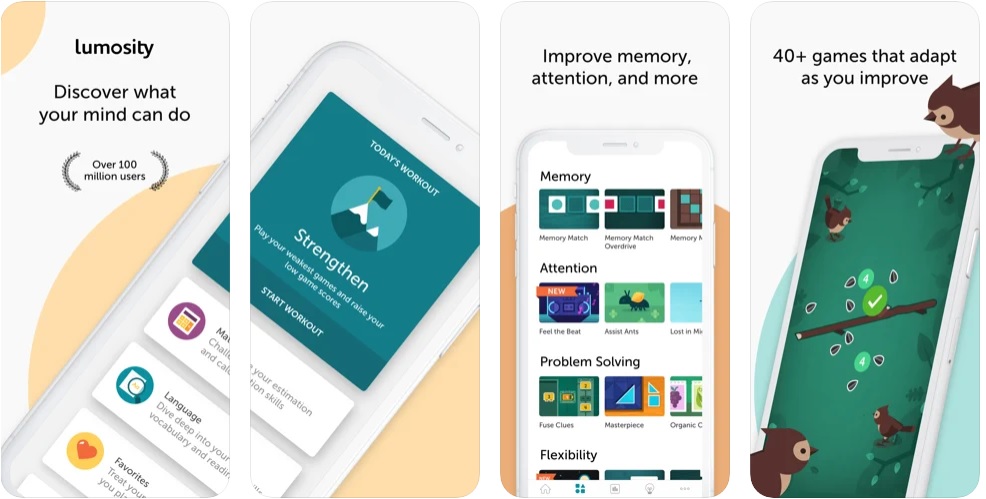
Both at work or school, individuals have been under immense pressure to perform, achieve, and perform these days! Constant stress can have adverse effects on a person’s well-being and must be handled. As per the reports, thousands of thoughts are expected to move through our minds every day. The figure grows as we get older, and our mental capacity weakens. Our memory is a muscle—if we want to keep it ready for daily activities, we have had to strengthen it.
Now, that doesn’t mean that you’re making a run for your closest therapist. The advent of smartphones, luckily, has enabled these exercises to be simpler than it has ever been. Presently, we have several mobile applications nowadays which enhance memory and concentration performance.
Scientifically developed brain training apps have indeed been meant to target specific areas of the human brain to control negative emotions such as fear and enhance mental health and cognitive sharpness. Brain training apps have gained popularity with such an elderly population concerned about cognitive loss. Google “Brain Training,” and you will find countless websites and apps promising to make you sharper, smarter, healthier, and make you intellectually flexible.
The brain training app industry is worth 6 billion currently. And you won’t believe one such app named Lumosity holds most of the market share alone. But what are brain training apps? How to develop an app like Lumosity? What development steps are necessary?
Through this blog, we’ll answer all the questions mentioned above and also share the must-have features of apps like lumosity. So without any further ado, let’s get straight onto the topic.
What are brain training apps?
Brain training apps are developed to boost your memory, cognitive capacity, attention, reasoning, and overall intellect. This is carried out in several different ways. Some applications include in-app games. In a game where you’ll have to finish certain activities to progress along to the next level, brain training apps are suitable for everyone. Both IOS and android devices have hundreds of brain training applications available. One such popular app is lumosity. But wait, with that said,
What is Lumosity?
 With in-App purchases, Lumosity is free. You have to play three games every day with the free edition. There are no boundaries for the premium membership. Before you continue to take other exams, you effectively start with such a 10-minute test of your existing cognitive skills. Players can see how they are progressing and eventually developing patterns that support these cognitive functions with both the ability to detect and monitor success over time.
With in-App purchases, Lumosity is free. You have to play three games every day with the free edition. There are no boundaries for the premium membership. Before you continue to take other exams, you effectively start with such a 10-minute test of your existing cognitive skills. Players can see how they are progressing and eventually developing patterns that support these cognitive functions with both the ability to detect and monitor success over time.
As Lumosity measures the player’s everyday activities, users can also see how successful they have already been in performing the activities over time and gradually establishing learning patterns designed to encourage better brain activity, including memory and attention.
Let’s see what numbers say about lumosity
- Lumosity has over 100 million user base.
- Lumosity has over 100K downloads in November 2020.
- The revenue of lumosity in November 2020 is 400K dollars.
Numbers are enough to clarify the potential and market demand for such apps. Now let’s answer the question from the title “How to develop an app like Lumosity?”
Well, developing an app is not an easy task. There are so many necessary steps to be followed to create a top-notch app like lumosity.
Don’t worry, below we’ve mentioned 8 important steps which you’ve to follow to develop an app like lumosity. So have a look!
8 steps you must follow to develop an app like lumosity
1. Explore the market and business in-depth
A comprehensive market analysis is an essential part of telling everything you are going forward. You ought to know the latest business offering and use this experience to identify avoid that your brain training app will fill and provide a new full solution to the issue you are solving.
Thorough research on the market can help you identify:
- Who are your rivals?
- What is their approach?
- What else are their advantages and shortcomings?
- What is their key selling point?
You will also be likely to dodge your rivals’ errors once you have the answers to all these questions, double up on the methods that work, and identify your specific perspective on the problem and the road to solving it. There seem to be hundreds of mobile brain training applications online, and this is your chance to make sure you stand out.
2. Define your pitch and target audience
Can you express the particular intent of your app? Can you call the difference between it and your website and its unique uses? For businesses and entrepreneurs, this is possibly the oddest move. It isn’t easy to simplify all your thoughts down to one or two phrases of simple intent, but it’s indeed one of the main steps to ensure your application’s success.
This is the time for the description of:
- What will be the main feature of the app?
- Why does it want to be used by individuals?
- Especially in comparison to a web version, what is the value-added?
- What business objectives would it help you accomplish?
- What audience is going to benefit from that?
- What is needed and craved by that audience?
While answering these questions, staying honest will guarantee that you don’t spend time on unnecessary app features or aimed at the wrong groups of individuals.
3. Select features and functionality of your app
We all know features and functionality play a vital role in an application’s success. For your brain training app like lumosity we’ve mentioned some must-have features, so take a look.
|
Must-Have Features |
|
|
|
4. Define app’s monetization model
For your company and your result, an app may play several distinct roles. It is apparent to generate revenue directly from the app. In contrast, others can serve as a source for your audience or help other facets of your marketing funnel implicitly and widen your brand’s depth.
What role throughout your business plan would you like your app to play? Now is the time to look at the app’s revenue models if you are looking to make money straight from your app.
- Freemium applications – Such applications can be downloaded free of charge, but some features and services are restricted and could only be unlocked with purchase.
- Paying (premium) software – Besides, the user needs to buy the app from the app store to use it. A mobile business model is essential to show the exclusive value proposition compared with free applications due to this mode’s cost constraint.
- In-app purchases – This approach works by using the application as a mobile shopping distribution platform to sell digital or physical goods.
- Subscriptions – This model is very similar to freemium applications but offers a benefit from a recurring revenue source.
- In-app advertising – This is probably the most comfortable model since there is no financial obstacle for the consumer. It’s essential to never compromise users’ experience, like with any free advertising, to obtain more ad space.
5. Define your marketing strategy
If there is an aspect that influences your application’s success so much, it is the planning to market. It amplifies it, involving your advertising, PR, pre-launch activities, outreach, and simple overall web presence.
Before you’ve started your development, you may think it’s premature to talk regarding marketing. That being said, if you start building the hype around your product before it was in the app stores, your actions will grow in the longer term.
- Define branding – How are you set beside the hundreds of many other applications and companies by your name, colors, logo, and the tone of your subject matter? Ensure that all these are consistent with your app and all the channels on which you exist.
- Find your platforms – Where does it mainly hang out with your target audience? Via social networking or email, are they easier to reach? Do they choose written material over video? How often time do they spend on mobile devices?
- And the last two points are creating your content and starting your outreach.
When the release time arrives, these measures will render promotion simpler, and you’ll have a friendly group with which to launch.
6. Do plan for ASO “App store optimization”
Numerous steps you have taken so far, particularly your market analysis, your brain training app’s unique intent, and your promotional strategies, will largely influence your app store optimization plan. It is necessary to follow both app stores’ criteria and best practices and use it as a key performance indicator for your application to flourish with its graphics, characteristics, and specific intent.
The main elements for the optimization of app stores are:
- Name of the app.
- Keywords.
- App logo.
- Screenshots.
- App description.
- Preview video (if any).
7. Know your assets
Ideally, to build the hype around your release, you will be able to announce your launch date ahead and make people wait for it cheerily. This is why you’d want to start discussions as soon as possible with your engineers and project managers. This could help you more efficiently direct your overall effort and assign relevant due dates to different stages of planning and growth, including:
- App definition.
- Mapping features and functionalities.
- Prototyping.
- Tech stack.
- Coding.
- Testing.
Fully understanding what tools you’re dealing with early will avoid later down the road any shortages and delays. Or, as an expert says, partnering up with the best app development firm will give you a headstart.
8. Ensure controls for app’s security
Finally, if your brain training app gathers any personal information from users, you must have terms of service. What information is being collected that is being used must be protected by this regulation. The advantage of taking this move so early is giving yourself more than enough time to get any legal advice you would need and prepare and enforce security measures inside the app.
The data of your users are your most valuable resource. You must ensure that you have procedures in place to capture, maintain, and store this information and manage any possible potential risks. If you’ve been through these stages of the project without disturbances, you will be prepared to delve into your app creation and drive it to smooth development and launch!
Final thoughts
Brain training applications serve a role that makes them an essential application that everyone on their mobile phones ought to have. We hope from the mentioned information in this blog and you are all set to develop your very own. In-case if you are looking for a professional brain training app Development Company, then contact Matellio. We would love to serve you.
or more, visit www.matellio.com.
Disclaimer: Please note that the content of this blog including links, texts, images, and graphics is only meant for informational purposes. We do not intend to infringe any copyright policy or do not possess any third-party material. If you have issues related to any of our content or images, kindly drop your message at info@matellio.com




